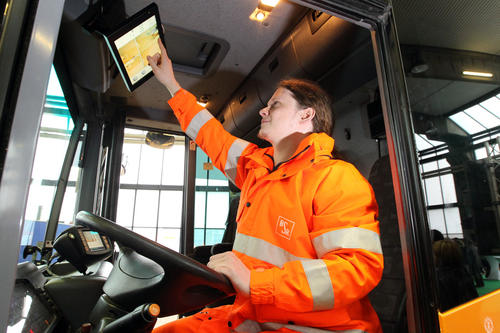Keeping an Eye on the Big Picture When Driving Backward
Intelligent assistance system for Berlin garbage trucks aims to prevent accidents; developed by Freie Universität spin-off
May 29, 2013
Every obstacle in view: A spin-off of Freie Universität, AutoNOMOS Systems has developed an intelligent camera system for Berlin’s city sanitation service, BSR, to assist drivers of garbage trucks when reversing.
Image Credit: Michael Brunner
Maneuvering a 26-ton vehicle through Berlin’s streets, some of which are quite narrow, is no easy task, even with rear-view and side mirrors, guidance from colleagues, and experience as a driver. As a result, garbage trucks in Berlin have repeatedly been involved in collisions with objects or – in the worst case – even with people. To prevent this, Berlin’s city sanitation service, BSR, engaged AutoNOMOS Systems, a company spun off from Freie Universität, to develop a concept to resolve the issue. The result is an intelligent camera system intended to help drivers of garbage trucks navigate in reverse. After a one-year development phase, the Reversing Assistance System (RAS) will be tested on the road for a year before it is decided whether additional BSR vehicles will be equipped with the system.
The team from AutoNOMOS Systems, headed by founders Patrick Vogel, Tinosch Ganjineh, and Michael Schnürmacher, is highly satisfied with the results that have emerged so far from its first order. Together with their mentor, computer science professor Raúl Rojas, who heads the Intelligent Systems and Robotics group at the Department of Mathematics and Computer Science at Freie Universität, the new entrepreneurs are taking an active approach to the issue of safe and secure mobility in the future – a question that affects the wider society. The spin-off, which is still new, is receiving funding from the German Federal Ministry of Education and Research (BMBF).
The centerpiece of the BSR project, Vogel says, is “protecting employees and pedestrians while supporting the driver, but without impeding working processes.” In the event of a crash, he says, both the victim and the driver face negative consequences.
To protect both sides, three prerequisites must be met: There must be special distance sensors such as 3D cameras, knowledge of process and working specifications, and functional interactions between the person and the machine. To achieve this, camera data must be prepared in such a way that the driver can understand them without further ado and respond accordingly.
The data are captured by stereo cameras installed as sensors in small metal cases in the rear of the truck. The special thing about the cameras is that they can film an area from different perspectives, thereby perceiving and representing depth and distance from objects. Sensors on the rear and sides of the vehicle monitor the area behind it and to the sides, since these areas are otherwise effectively invisible from the driver’s cab.
If there is a person, animal, or object in these blind spots, the system identifies the risk. A warning signal is sounded, and the obstacle appears in red on the monitor in the driver’s cab. The driver can now respond appropriately or turn off the signal, which a driver might do when being trained by other BSR employees, for instance. If the driver does not respond, future plans call for the vehicle to be able to stop automatically – a big step in the right direction, says Tinosch Ganjineh, as computers respond much faster than humans.
The running boards on both sides of the loading hatch and the lifter that hoists the garbage cans and dumps the waste into the truck also pose potential hazards to employees and pedestrians. As a result, the cameras also monitor these areas. “Ultimately,” Ganjineh says, “the system is backed by a high level of technology and know-how and by complex data analysis algorithms.” He adds, though, that the driver receives only the information he or she needs in order to take action promptly.
One garbage truck has been equipped with RAS so far. The goal is to test the system’s suitability for use in everyday operations and find out how willing BSR employees are to accept the new technology. After all, the success of this development ultimately depends on how people interact with the machine.
The prototype of the camera system is being tested on multiple routes in order to take various danger situations and particularities of road traffic into account. The one-year test phase now under way is supposed to show what technological adjustments need to be made. Only after that will a decision be made as to whether the system will be installed in series production in the trucks in the future and whether it may also be suitable for other special types of vehicles aside from Berlin’s sanitation trucks.
Further Information
Patrick Vogel, Freie Universität Berlin, Department of Mathematics and Computer Science, Institute of Computer Science - Intelligent Systems and Robotics Group, Tel.: +49 30 838 75149, Email: patrick.vogel@fu-berlin.de

